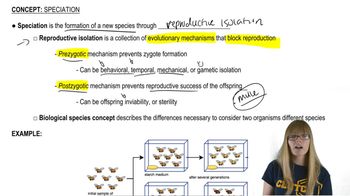What are the functions of lncRNAs in epigenetic regulation? Describe each in detail.
Table of contents
- 1. Introduction to Genetics51m
- 2. Mendel's Laws of Inheritance3h 37m
- 3. Extensions to Mendelian Inheritance2h 41m
- 4. Genetic Mapping and Linkage2h 28m
- 5. Genetics of Bacteria and Viruses1h 21m
- 6. Chromosomal Variation1h 48m
- 7. DNA and Chromosome Structure56m
- 8. DNA Replication1h 10m
- 9. Mitosis and Meiosis1h 34m
- 10. Transcription1h 0m
- 11. Translation58m
- 12. Gene Regulation in Prokaryotes1h 19m
- 13. Gene Regulation in Eukaryotes44m
- 14. Genetic Control of Development44m
- 15. Genomes and Genomics1h 50m
- 16. Transposable Elements47m
- 17. Mutation, Repair, and Recombination1h 6m
- 18. Molecular Genetic Tools19m
- 19. Cancer Genetics29m
- 20. Quantitative Genetics1h 26m
- 21. Population Genetics50m
- 22. Evolutionary Genetics29m
13. Gene Regulation in Eukaryotes
Epigenetics, Chromatin Modifications, and Regulation
Problem 13
Textbook Question
What are the differences and similarities among the three classes of monoallelic gene expression?
 Verified step by step guidance
Verified step by step guidance1
Step 1: Define monoallelic gene expression as the phenomenon where only one allele of a gene is expressed while the other allele is silenced, which can occur in different contexts and mechanisms.
Step 2: Identify the three main classes of monoallelic gene expression: genomic imprinting, X-chromosome inactivation, and random monoallelic expression of autosomal genes.
Step 3: Explain genomic imprinting as a parent-of-origin specific expression where either the maternal or paternal allele is epigenetically silenced, leading to expression from only one parental allele.
Step 4: Describe X-chromosome inactivation as a process in female mammals where one of the two X chromosomes is randomly inactivated in each cell to balance gene dosage between males and females.
Step 5: Discuss random monoallelic expression of autosomal genes, where one allele is randomly chosen for expression in each cell, independent of parental origin, leading to cellular mosaicism.
 Verified video answer for a similar problem:
Verified video answer for a similar problem:This video solution was recommended by our tutors as helpful for the problem above
Video duration:
1mPlay a video:
Was this helpful?
Key Concepts
Here are the essential concepts you must grasp in order to answer the question correctly.
Monoallelic Gene Expression
Monoallelic gene expression occurs when only one allele of a gene is actively transcribed while the other allele is silenced. This selective expression can influence cellular diversity and gene regulation, playing a key role in processes like immune response and development.
Recommended video:
Guided course

Penetrance and Expressivity
Types of Monoallelic Expression
The three main classes are random monoallelic expression, genomic imprinting, and X-chromosome inactivation. Random monoallelic expression occurs stochastically in autosomal genes, imprinting involves parent-of-origin specific expression, and X-inactivation silences one X chromosome in females to balance gene dosage.
Recommended video:
Guided course

Penetrance and Expressivity
Mechanisms and Biological Significance
Each class uses distinct epigenetic mechanisms such as DNA methylation and histone modifications to maintain allele-specific expression. These mechanisms ensure proper development, dosage compensation, and immune diversity, highlighting both shared and unique regulatory strategies among the classes.
Recommended video:
Guided course

Speciation
Related Videos
Related Practice
Textbook Question
637
views


